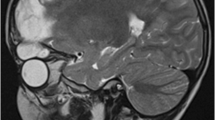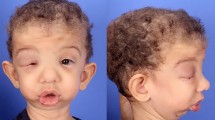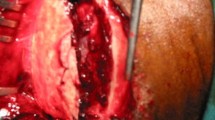Summary
Growing skull fractures are rare complications of head injury, occurring almost exclusively in infants and children under the age of three. A retrospective review at our Institute yielded 41 patients with this entity over a period of 20 years (1975–1995). The age at presentation ranged from less than 1 year to 62 years, with 33 (80.5%) patients being less than 5 years of age. The cause of injury was either a fall from a height (93%) or a road traffic accident. The most common location of a growing skull fracture was either parietal or frontoparietal (56%). One patient had a posterior fossa growing skull fracture. CT scan was performed in 19 patients which demonstrated an underlying porencephalic cyst, hydrocephalus or a cyst communicating with the ventricle.
In 5 children, a ventriculo-peritoneal shunt alone was performed. Twenty four patients underwent a duro- and cranioplasty while a duroplasty alone was performed in 8 patients. The material used for cranioplasty included acrylic, wire mesh, steel plates or autologous bone. Three patients died, one due to an anaesthetic complication and two as a result of postoperative meningitis. Post-operative CSF leaks occurred in 3 patients, which were managed by a lumbar drain. Six patients had local wound infection.
Similar content being viewed by others
References
Arseni C, Ciurea AV (1981) Clinicotherapeutic aspects in the growing skull fracture: a review of the literature. Childs Brain 8: 161–172
Byrne JV, Britten JA, Kaar G (1992) Chronic post-traumatic erosion of the skull base. Neuroradiology 34: 526–531
Dunsker SB, McCreary HS (1971) Leptomeningeal cysts of the posterior fossa. J Neurosurg 34: 687–692
Gruber FH (1969) Posttraumatic leptomeningeal cyst. Am J Radiol 105: 305–307
Halliday AC, Chapman PH, Heros RC (1990) Leptomeningeal cyst resulting from adulthood trauma. Case report. Neurosurgery 26: 150–153
Hillman RSL, Kieffer SA, Ortiz H, Clubb R (1975) Intraosseus leptomeningeal cysts of the posterior fossa. Radiology 116: 655–659
Howship PJ (1816) Practical observations in surgery and morbid anatomy. Longman, London, p 494
Ito H, Miwa T, Onodra T (1977) Growing skull fractures of childhood. Childs Brain 3: 116–126
Kaijima M, Maeyama R (1981) Intradiploic leptomeningeal cysts of the posterior fossa. A case report. Neurol Med Chir (Tokyo) 21: 785–787
Kingsley D, Till K, Hoare R (1978) Growing fractures of the skull. J Neurol Neurosurg Psychiatry 41: 312–318
Lende R, Erickson T (1961) Growing skull fractures of childhood. J Neurosurg 18: 479–489
Muhonen MG, Piper JG, Menezes AH (1995) Pathogenesis and treatment of growing skull fractures. Surg Neurol 43: 367–373
Nemoto S, Hoffman HJ (1986) Leptomeningeal cyst of the posterior fossa. J Neurosurg 65: 704–705
Palaoglu S, Beskonakli E, Senel K, Taskin Y, Yaleinlar Y (1990) Intraosseus location of posterior fossa posttraumatic leptomeningeal cyst. Neuroradiology 32: 78
Peyser E, Weissberg D (1961) Posttraumatic arachnoid cyst: Report of an unusual case. J Neurosurg 18: 557–553
Rahman Nain Vr, Abedeen B, Tanjoom ZA, Tanjoom HB, Murshid WR (1994) Growing skull fractures. Classification and management. Br J Neurosurg 8: 667–679
Ramamurthi B, Kalyanaraman S (1970) Rational for surgery in growing fractures of the skull. J Neurosurg 32: 427–430
Rothman L, Rose JS, Laster DW, Quencer R, Tenner M (1970) The spectrum of growing skull fractures in children. Pediatrics 57: 26–31
Singh FB, Khosla VK, Gupta SK, Manjunath Prasad KS (1994) Growing fracture of the skull: Report of an unusual case. Surg Neurol 42: 165–167
Tendon PN, Banerji AK, Bhatia R, Goulatia RK (1987). Cranio-cerebral erosion (Growing fracture of the skull in children). Part II: clinical and radiological observations. Acta Neurochir (Wien) 88: 1–9
Taveras J, Ransohoff S (1953) Leptomeningeal cysts of the brain following trauma with erosion of the skull: a study of seven cases treated by surgery. J Neurosurg 10: 233–241
Winston K, Beatty RM, Fisher EG (1983) Consequences of durai defects acquired in infancy. J Neurosurg 59: 839–846
Author information
Authors and Affiliations
Rights and permissions
About this article
Cite this article
Gupta, S.K., Reddy, N.M., Khosla, V.K. et al. Growing skull fractures: A clinical study of 41 patients. Acta neurochir 139, 928–932 (1997). https://doi.org/10.1007/BF01411301
Issue Date:
DOI: https://doi.org/10.1007/BF01411301




